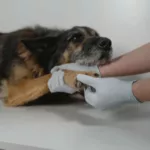The Pandemic has taught us one thing, that is that we need better home healthcare options. Hospitals were overwhelmed, some still are, and being able to use the beds that people already have while keeping healthcare workers remote and safer would have been, and will be, a considerable godsend. Last week Qualcomm walked the analysts through a Hospital At Home scenario that promised a future where you could potentially get most of the services you now get at a hospital, short of surgery (for now) in your home using a system of 5G connected devices and robots.
Today, as I was writing this, I had to go in for a checkup, and while the Doctor did enter the room with me, instead of the average assistant taking notes, she brought in a tablet on a stand. This tablet connected to the assistant, who was remote, taking notes and watching me through the tablet’s camera. Given the Doctor never touched me, I could have done the entire visit with a small scale, blood pressure sleeve, and an easy way to get my height solo. Granted, I still would have had to come in for my PSA test, but that could have just been a trip to a closer lab. Everything else could have been handled remotely.
Let’s talk about the future of Healthcare today.
Hospital At Home
Much like it has been for many of us shifting to working from home, the future Hospital At Home would consist of remotely connected equipment for monitoring and testing connected to a high-speed back end. The advantage of going wireless over wired with 5G is that you should get similar bandwidth, but the Healthcare provider doesn’t have to worry about securing the network connection; the hardware securely connects to the central office when plugged in.
Cameras, sensors, and screens allow the remote medical staff to monitor the patient and receive alerts if the patients need extra care. EMTs or other medical staff can be automatically dispatched if it looks like a problem that can’t be handled remotely emerges.
Even in the hospital, ICUs can be monitored real-time with automated equipment that can respond to a medical emergency more quickly. Remote ICUs could be set up on the site of a disaster providing care more quickly to more significant numbers of injuries and allowing patients to be stabilized better before transport.
Other benefits of a blend of remote and hospital-based technology are that patent data would be more up to date, concerns that don’t need a hospital or doctor visit can be better addressed, and there is less chance for the medical staff to contract illnesses because they remain remote.
Another coming feature is that needed accessories could be fast shipped (eventually carried by drones) to the patent and connected wirelessly to either the local or remote secure medical hub. Healthcare providers, thanks to standards, will be able to mix and match hardware as necessary and both assure comprehensive care and a lower medical cost.
(This would certainly help those that found they had to live away from home to protect their families because this remote technology would allow many of these folks to contribute from home.)
In short, with everything contained, securely connected, and monitored, the patent wouldn’t even need a Smartphone, only a place to set the device(s) and a power plug.
Wrapping up:
We are moving towards a time when doctors and patients don’t need to be in physical proximity to interact. Robots can be remotely controlled to provide some medical services, and both patients and healthcare workers can increasingly work from home. Even surgery, using a robot, could be done in remote areas that currently lack a convenient doctor. States are beginning to fund this effort with $266.8B, and even employers are stepping up (80% of US self-insured employers paid for Telehealth.
Qualcomm is setting up joint reference solutions, enabling partner ecosystems, and working on projects like remote surgical robots to make this future a reality. This coming technology should make the next Pandemic far easier to get through and remove massive pressure from medical first responders.
While we are a ways from the medical equipment portrayed in Elysium, we are far closer than most of us likely realized.







